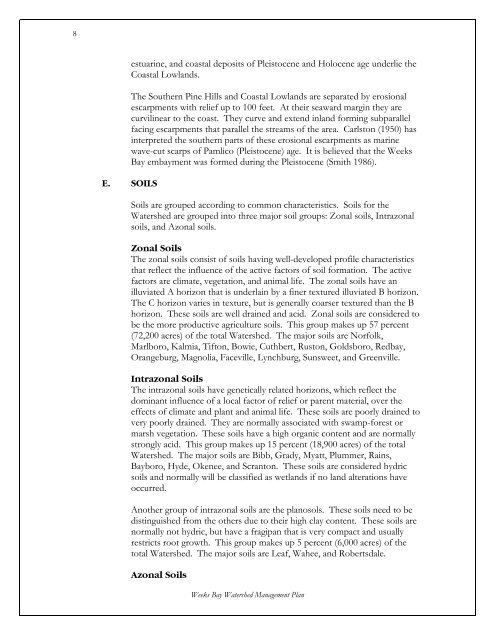Weeks Bay Watershed Project Management Plan - Mobile Bay ...
Weeks Bay Watershed Project Management Plan - Mobile Bay ...
Weeks Bay Watershed Project Management Plan - Mobile Bay ...
You also want an ePaper? Increase the reach of your titles
YUMPU automatically turns print PDFs into web optimized ePapers that Google loves.
8<br />
estuarine, and coastal deposits of Pleistocene and Holocene age underlie the<br />
Coastal Lowlands.<br />
The Southern Pine Hills and Coastal Lowlands are separated by erosional<br />
escarpments with relief up to 100 feet. At their seaward margin they are<br />
curvilinear to the coast. They curve and extend inland forming subparallel<br />
facing escarpments that parallel the streams of the area. Carlston (1950) has<br />
interpreted the southern parts of these erosional escarpments as marine<br />
wave-cut scarps of Pamlico (Pleistocene) age. It is believed that the <strong>Weeks</strong><br />
<strong>Bay</strong> embayment was formed during the Pleistocene (Smith 1986).<br />
E. SOILS<br />
Soils are grouped according to common characteristics. Soils for the<br />
<strong>Watershed</strong> are grouped into three major soil groups: Zonal soils, Intrazonal<br />
soils, and Azonal soils.<br />
Zonal Soils<br />
The zonal soils consist of soils having well-developed profile characteristics<br />
that reflect the influence of the active factors of soil formation. The active<br />
factors are climate, vegetation, and animal life. The zonal soils have an<br />
illuviated A horizon that is underlain by a finer textured illuviated B horizon.<br />
The C horizon varies in texture, but is generally coarser textured than the B<br />
horizon. These soils are well drained and acid. Zonal soils are considered to<br />
be the more productive agriculture soils. This group makes up 57 percent<br />
(72,200 acres) of the total <strong>Watershed</strong>. The major soils are Norfolk,<br />
Marlboro, Kalmia, Tifton, Bowie, Cuthbert, Ruston, Goldsboro, Redbay,<br />
Orangeburg, Magnolia, Faceville, Lynchburg, Sunsweet, and Greenville.<br />
Intrazonal Soils<br />
The intrazonal soils have genetically related horizons, which reflect the<br />
dominant influence of a local factor of relief or parent material, over the<br />
effects of climate and plant and animal life. These soils are poorly drained to<br />
very poorly drained. They are normally associated with swamp-forest or<br />
marsh vegetation. These soils have a high organic content and are normally<br />
strongly acid. This group makes up 15 percent (18,900 acres) of the total<br />
<strong>Watershed</strong>. The major soils are Bibb, Grady, Myatt, Plummer, Rains,<br />
<strong>Bay</strong>boro, Hyde, Okenee, and Scranton. These soils are considered hydric<br />
soils and normally will be classified as wetlands if no land alterations have<br />
occurred.<br />
Another group of intrazonal soils are the planosols. These soils need to be<br />
distinguished from the others due to their high clay content. These soils are<br />
normally not hydric, but have a fragipan that is very compact and usually<br />
restricts root growth. This group makes up 5 percent (6,000 acres) of the<br />
total <strong>Watershed</strong>. The major soils are Leaf, Wahee, and Robertsdale.<br />
Azonal Soils<br />
<strong>Weeks</strong> <strong>Bay</strong> <strong>Watershed</strong> <strong>Management</strong> <strong>Plan</strong>
















